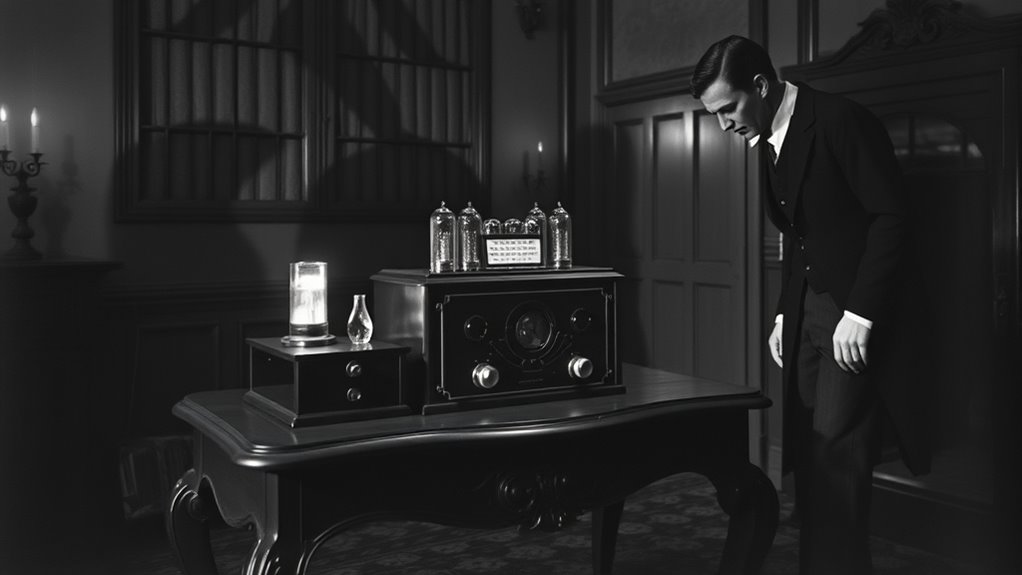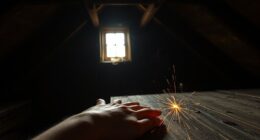Edison’s “Spirit Phone” was a mysterious device rumored to be created in the 1920s, aimed at communicating with spirits and bridging the living and the dead. Although there’s no concrete evidence Edison actually built it, stories say it resembled a vintage radio with dials and meters to detect supernatural signals. This ghost gadget sparked media frenzy and inspired myths about tapping into the afterlife, but skepticism remains. If you’re curious, you’ll discover more secrets behind this intriguing legend.
Key Takeaways
- The “Spirit Phone” is a speculative device attributed to Thomas Edison, allegedly designed in the 1920s to communicate with spirits.
- Its design features resemble vintage radios or telephones with mystical controls and meters, blending technology and spiritualism.
- No concrete evidence confirms the device’s existence; it remains a myth fueled by conspiracy theories and Edison’s rumored paranormal interests.
- Public reactions included media sensationalism and demonstrations, but skeptics questioned its scientific plausibility.
- The “Spirit Phone” symbolizes societal hopes and fears about technological contact with the supernatural, influencing paranormal culture and lore.
The Origins of the Spirit Phone Rumor
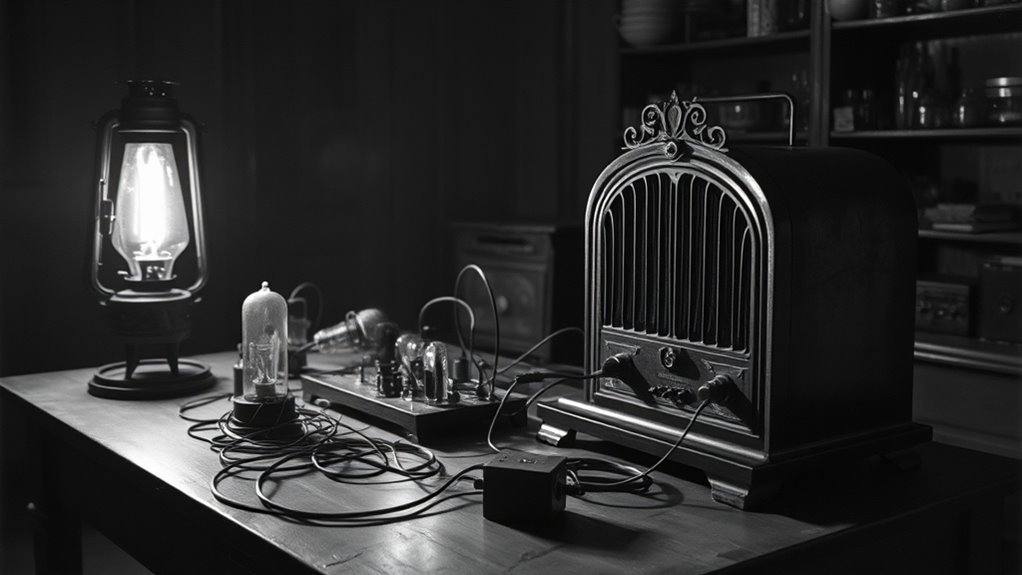
The story of Edison’s “Spirit Phone” begins with a mix of speculation and conspiracy theories that have persisted for decades. Rumors suggest Edison secretly worked on paranormal communication devices, blending his passion for technological innovation with the desire to contact spirits. These whispers gained traction in the early 20th century, fueled by stories of Edison’s interest in the supernatural and unexplained phenomena. Some believe Edison’s experiments aimed to create a device that could connect the living with the dead, pushing the boundaries of science and mysticism. Although no concrete evidence exists, the idea of a spirit phone captures the imagination, intertwining Edison’s reputation as an inventor with the allure of the unknown. This blend of science and the supernatural fuels ongoing curiosity and speculation. Self Watering Plant Pots are an example of innovative technology designed to simplify plant care and maintain optimal moisture levels, similar to the way the spirit phone concept merges science with mysticism. Additionally, the fascination with AI security vulnerabilities underscores how technological risks can fuel myths and conspiracy theories about secret devices and experiments. The persistent allure of technological mysteries continues to inspire stories that blur the line between fact and fiction. Furthermore, the speculation surrounding Edison’s work reflects broader themes of technological innovation and the human fascination with the unknown. Some researchers suggest that our cultural fascination with spirits has historically influenced the way these stories develop and persist over time.
Thomas Edison’S Fascination With the Unknown
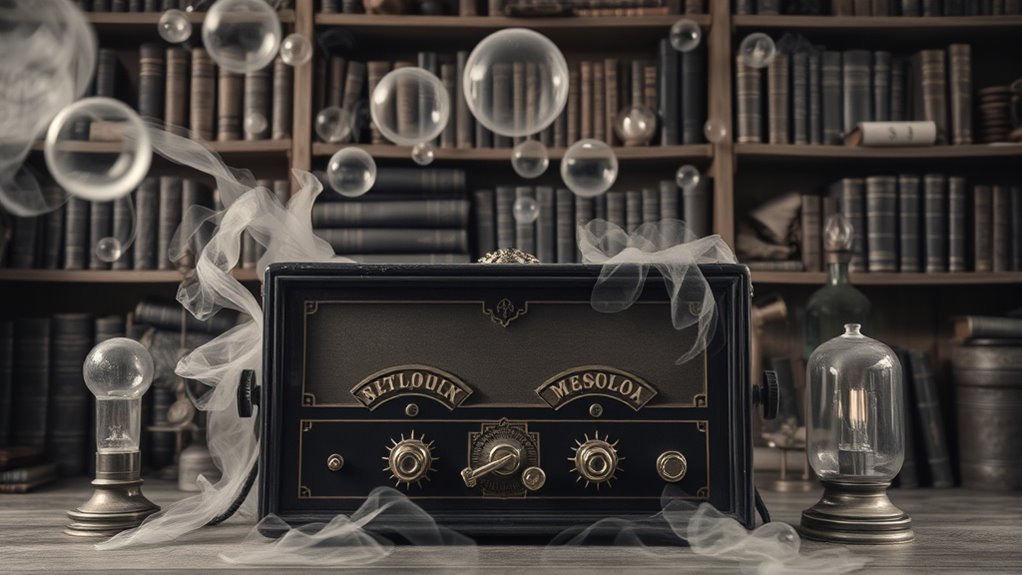
You might be surprised to learn that Edison was deeply curious about spirits and the afterlife. His relentless drive to invent the impossible shows he wasn’t satisfied with just practical science. Instead, he explored mysteries beyond our world, eager to uncover secrets others dared not pursue. Interestingly, his fascination extended into paranormal research, reflecting a desire to bridge science and the unknown. This curiosity aligns with the broader concept that creativity can be cultivated by anyone, and Edison’s willingness to experiment with unconventional ideas exemplifies a fearless approach to discovery. Additionally, his interest in inspirational quotes about fatherhood underscores how influential personal relationships and curiosity can be in inspiring groundbreaking ideas. Exploring cultural significance of historical sites like Eremo Di Montesiepi reveals how history and spirituality can influence innovative thinking. Moreover, his endeavors demonstrate how renewable energy innovations can inspire new ways of thinking about energy and technology.
Curiosity About Spirits
Thomas Edison’s fascination with the unknown extended beyond his inventions into the domain of spirits and the afterlife. You might imagine him pondering spiritual communication, enthusiastic to bridge the gap between the living and the dead. His curiosity was fueled by supernatural beliefs and a desire to prove that contact with spirits was possible through science. Picture Edison studying flickering lights, strange whispers, or devices that could detect unseen energies. He believed that understanding these phenomena could reveal secrets of life after death. His interest wasn’t just speculative; he envisioned technology that could connect souls. This curiosity drove him to explore ideas that blurred the line between science and the supernatural, fueling his obsession with the idea of a “spirit phone.” Additionally, his exploration of technological innovation in this field reflected his relentless pursuit of scientific breakthroughs. By examining electrical phenomena, Edison hoped to uncover evidence of the supernatural and harness it through technology, believing that energy transfer might hold the key to communication beyond the physical realm.
Inventing the Impossible
Driven by an insatiable curiosity, Edison relentlessly pursued ideas that seemed to defy the boundaries of science and possibility. His drive for technological innovation pushed him to explore concepts others considered impossible, like capturing spirits through electrical devices. Edison saw these pursuits not just as scientific challenges but as cultural symbols of progress, blending science with mysticism. His fascination with inventing the impossible reflected a desire to bridge the known and unknown worlds, transforming abstract ideas into tangible inventions. You can see this mindset in his work on the “Spirit Phone,” where he aimed to uncover communication with spirits, challenging the limits of technology and belief. This pursuit exemplifies his innovative approach, embodying a daring spirit that shaped both scientific innovation and cultural perceptions of the unknown. Additionally, his efforts to explore digital literacy and the integration of technology in family activities demonstrate his forward-thinking attitude towards embracing new frontiers.
Exploring the Afterlife
Have you ever wondered what lies beyond life as we comprehend it? Edison’s fascination with the afterlife led him to explore ideas rooted in the spiritualism movement. He believed that science could reveal the secrets of the spirit world, inspired by concepts like quantum entanglement—where particles remain connected across distances. Imagine séances where voices from the beyond could be transmitted through a device Edison hoped to perfect. Envision a world where technology bridges the gap between the living and the dead, capturing whispers or fleeting images. His curiosity drove him to experiment with ideas that blurred the line between science and the supernatural, aiming to prove that consciousness endures beyond death. Edison’s obsession was fueled by a desire to uncover the unknown, no matter how elusive. The connection between high-pressure technology and his experiments highlights his relentless pursuit of pushing scientific boundaries to explore the mysterious.
The Design and Alleged Features of the Spirit Phone
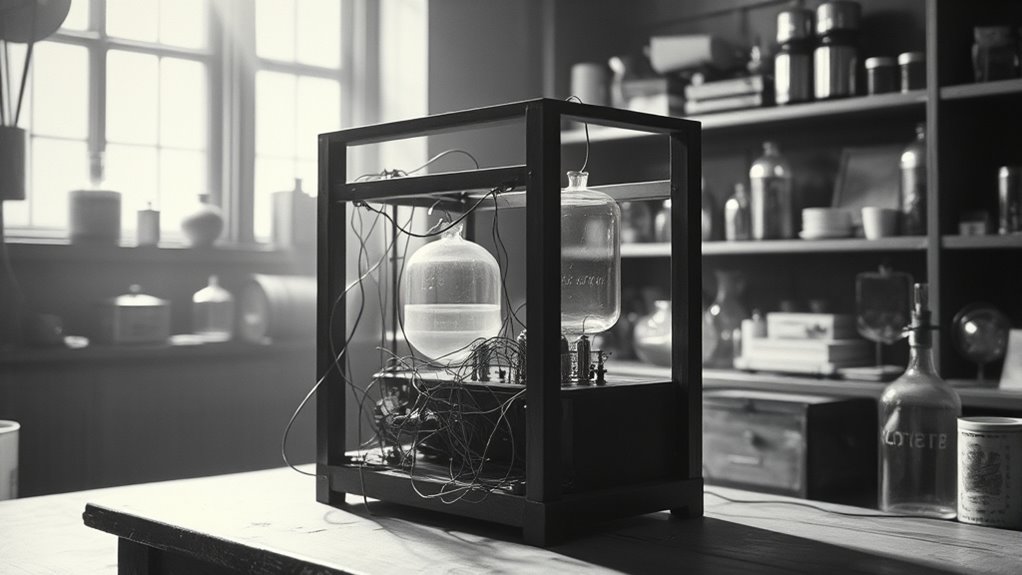
The design of Edison’s “Spirit Phone” is shrouded in mystery and speculation, but descriptions suggest it resembles a vintage radio or telephone, with dials, meters, and a speaker grille. Its appearance hints at a blend of technological innovation and spiritual experimentation, aiming to bridge the physical and spiritual worlds. Some accounts claim it featured unusual controls for tuning into supposed spiritual frequencies, while others mention meters that supposedly detected supernatural signals. Edison’s goal was to create a device that could communicate with spirits, blending scientific principles with spiritual pursuits. Although its exact design remains uncertain, the Spirit Phone’s alleged features reflect a bold attempt to harness technology for metaphysical exploration, capturing the era’s fascination with both innovation and the afterlife.
Public Reactions and Media Sensations
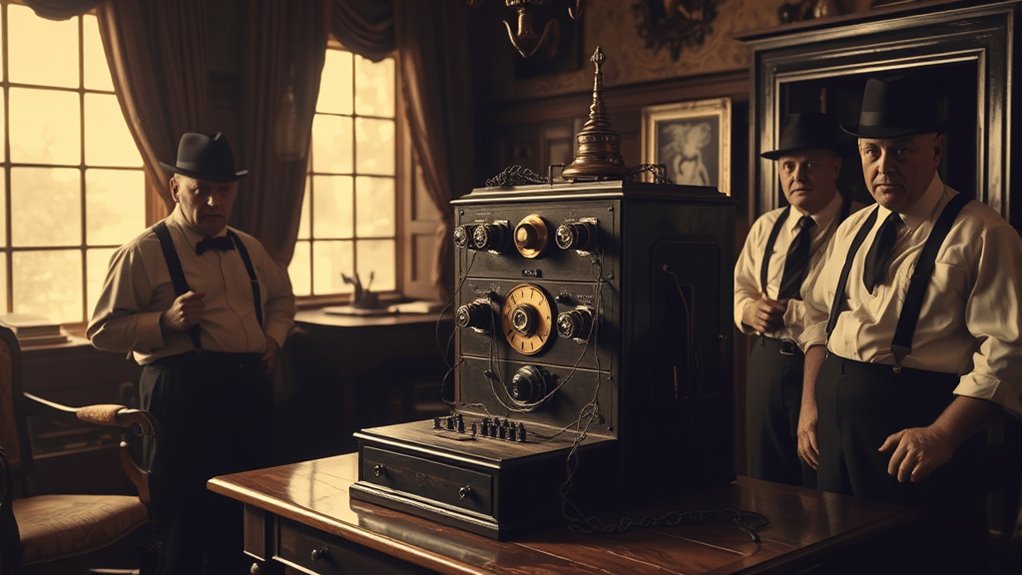
When news of Edison’s so-called “Spirit Phone” surfaced, it sparked immediate media frenzy and public curiosity. People flocked to newspapers and radio shows, anxious to learn more about the supposed ghost communication device. The media hysteria created vivid images of spirits chatting with the living, fueling both fascination and fear. You might have seen headlines like “Edison’s Mysterious Device Opens Door to the Afterlife” or read stories describing séances interrupted by strange noises. The public’s imagination ran wild, imagining spirits whispering secrets from beyond. Crowds gathered at demonstrations, hoping to witness the supernatural firsthand. This wave of excitement turned Edison’s invention into a cultural sensation, blending science and the supernatural in a way that captured everyone’s attention.
Skepticism and Debunking Efforts
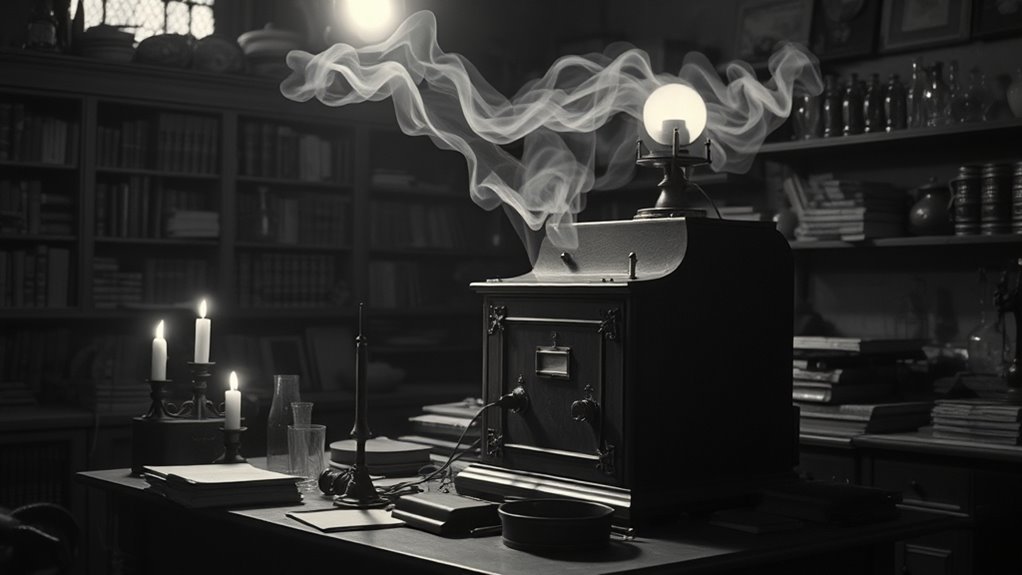
Many skeptics question whether Edison’s “Spirit Phone” is even possible, citing the scientific challenges involved. They demand solid evidence before accepting claims of communicating with spirits through technology. Without convincing proof, doubts remain about the device’s legitimacy and purpose.
Scientific Challenges Faced
Skepticism and debunking efforts have long challenged the credibility of Edison’s “Spirit Phone” claims. The primary scientific challenges involve technological limitations that prevent reliable communication with spirits. Many critics argue that the device’s design lacked scientific validity, relying on misunderstood or misapplied principles. You might imagine:
- Complex circuits that produce ambiguous signals
- Inconsistent results that defy repeatability
- Lack of controlled experiments to verify claims
- Electrical noise mistaken for spirit voices
- Misinterpretation of static as communication
These issues highlight how the device’s supposed abilities clash with established scientific understanding. Without rigorous testing or proof, the “Spirit Phone” remains more of a myth rooted in speculation than a credible technological breakthrough.
Evidence and Skepticism
Despite the persistent claims surrounding Edison’s “Spirit Phone,” there is little credible evidence to support its existence. Technological skepticism runs deep when it comes to devices claiming to contact spirits, and most experts question its scientific validity. Investigations and debunking efforts have shown that supposed evidence is often based on misinterpretations or hoaxes. No verifiable experiments or technological breakthroughs have ever confirmed the device’s functionality. Skeptics point out that claims are driven more by sensationalism than by scientific rigor. Without concrete proof, the “Spirit Phone” remains a fascinating legend rather than a genuine invention. Your critical perspective is essential in discerning fact from fiction, especially when extraordinary claims lack supporting scientific validation.
The Cultural Impact of the Ghost Gadget
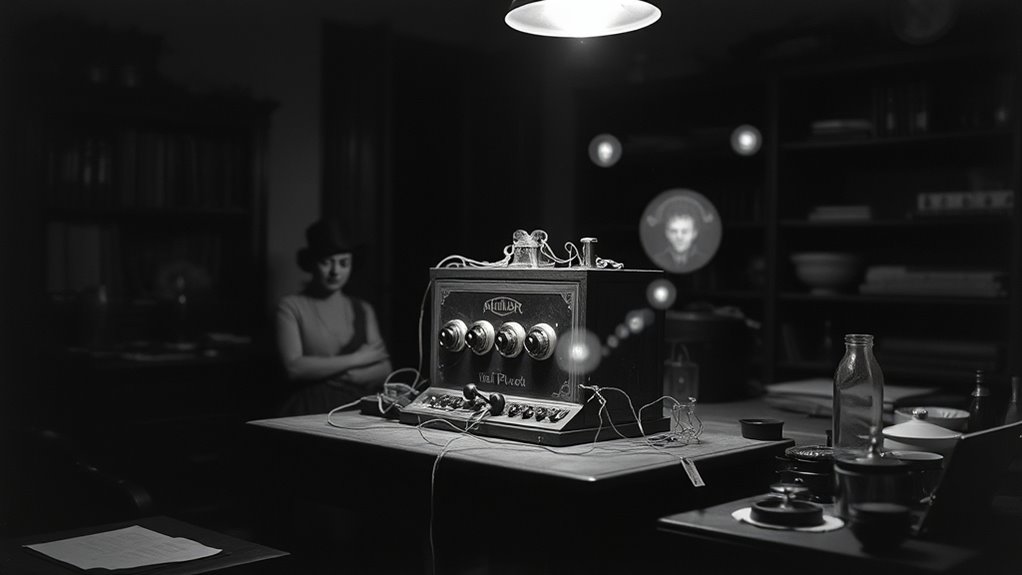
Edison’s “Spirit Phone” has left a lasting mark on popular culture, inspiring stories, myths, and debates about the afterlife and technological possibility. It fueled imaginations about bridging worlds through innovation, reflecting society’s fears of death and the unknown. This gadget became a symbol of both hope and skepticism, sparking discussions about whether technology could unseal supernatural secrets. It influenced movies, books, and paranormal lore, embedding itself into a cultural narrative about life after death. You might imagine:
- Ghostly voices crackling through vintage radios
- Inventors obsessed with contacting the beyond
- The clash between science and superstition
- Fear of technology surpassing human control
- A society captivated by the idea of eternal communication
The Spirit Phone embodies a blend of technological innovation and societal fears, shaping cultural attitudes toward life, death, and the limits of science.
Comparing the Spirit Phone to Modern Paranormal Tech
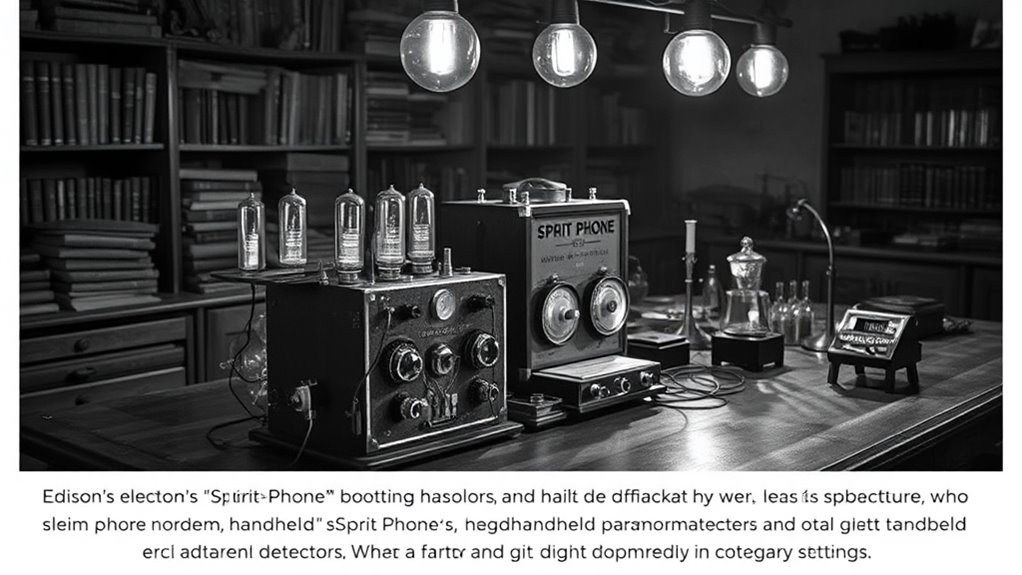
Modern paranormal technology has advanced considerably since Edison’s time, offering a range of devices that claim to facilitate communication with spirits or detect supernatural activity. Unlike Edison’s Spirit Phone, which relied on speculative electrical signals, today’s tools utilize technological innovation such as EMF meters, EVP recorders, and spirit boxes. These devices aim to enhance paranormal communication by capturing electronic voice phenomena or detecting unusual energy patterns. While the Spirit Phone was rooted in a blend of curiosity and emerging technology, modern equipment often emphasizes scientific approaches, even if their validity remains debated. Despite differences in sophistication, both eras reflect a desire to bridge the mortal and spiritual worlds through technology. The evolution highlights how paranormal tech continuously seeks to push boundaries and deepen our understanding of the supernatural.
The Legacy and Mystique of Edison’s Apparitions
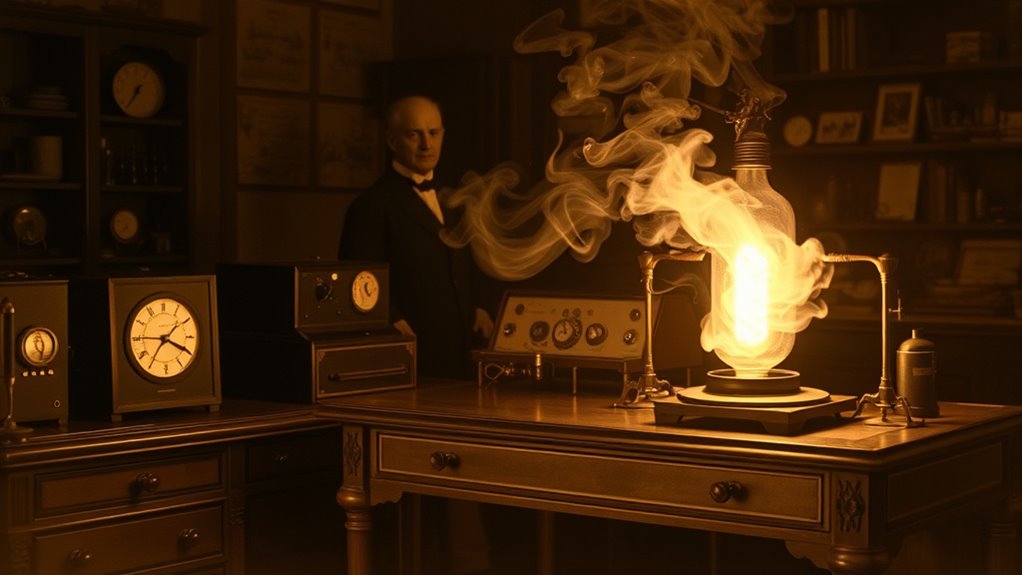
The mystique surrounding Edison’s apparitions continues to captivate both skeptics and believers, fueling speculation about the boundaries between science and the supernatural. His supposed spirit communication sparks curiosity about whether technology can bridge life and beyond. Edison’s legacy in technological innovation fuels the idea that his inventions might have discovered secret channels for spiritual communication. Images of ghostly voices emerging from vintage equipment, flickering lights in darkened rooms, and mysterious messages transmitted across time evoke a haunting sense of wonder. You might picture:
- Edison’s face appearing on old radio screens
- Whispered voices from ghostly devices
- Faint flickers in abandoned laboratories
- Apparitions seen through makeshift spirit boxes
- A sense of unseen energy connecting past and present
This blend of science and the supernatural keeps his legend alive.
What the Spirit Phone Tells Us About 1920s Society
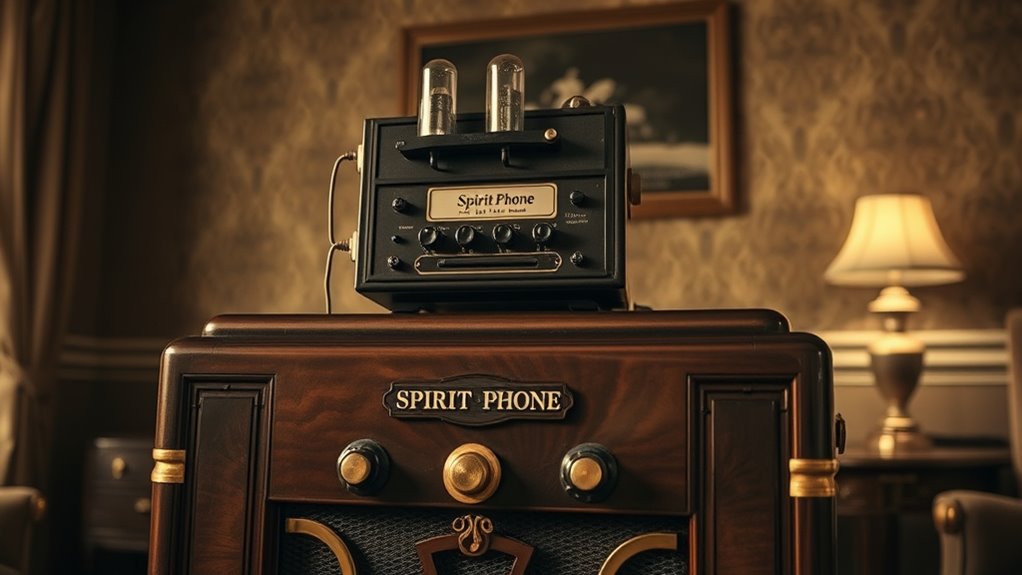
The fascination with Edison’s alleged spirit communication reflects more than just curiosity about the supernatural; it offers insight into the hopes, fears, and cultural landscape of the 1920s. You see, this obsession reveals a society caught between technological optimism and spiritual skepticism. People believed in progress and innovation but also questioned what could lie beyond physical existence.
| Technological Optimism | Spiritual Skepticism |
|---|---|
| Embracing new gadgets | Doubting supernatural claims |
| Belief in progress | Fear of unknown forces |
| Scientific faith | Wariness of spirits |
| Innovation as hope | Seeking proof or rejection |
This tension shaped how society viewed the Spirit Phone—an emblem of both modern progress and lingering doubts about the unseen.
Frequently Asked Questions
Did Edison Ever Publicly Endorse or Deny the Spirit Phone?
You might wonder about Edison’s stance on the spirit phone, but he never publicly endorsed or outright denied it. His comments sparked public skepticism, as many believed he was exploring the supernatural, while others thought he was just interested in advanced communication. Edison kept a cautious silence, fueling speculation without confirming or rejecting the device’s legitimacy. His ambiguous stance left people questioning his true beliefs about spirits and the afterlife.
What Scientific Experiments Were Conducted to Test the Spirit Phone’S Claims?
Imagine you’re stepping into a world of technological skepticism and paranormal investigations, seeking proof of the spirit phone’s claims. You discover scientists conducted experiments, like radio wave analysis and electrical interference tests, trying to detect ghostly signals. Despite these efforts, results remained inconclusive, fueling doubts. The experiments reveal how brave researchers ventured into uncharted territory, questioning science’s limits, yet ultimately leaving the spirit phone’s true nature shrouded in mystery and suspense.
Are Any Existing Prototypes or Artifacts of the Spirit Phone Preserved Today?
You might wonder if any ghost phone prototypes or artifacts are still around today. Unfortunately, there’s no verified preservation of actual ghost phone devices, as most evidence is anecdotal or theoretical. If you’re interested in ghost phone artifacts, you should explore museums or private collections focused on paranormal history. While no original ghost phone artifacts are confirmed to exist, the idea continues to intrigue enthusiasts and researchers alike.
How Did Spiritualism Influence the Development of the Spirit Phone Rumor?
You see, spiritualism heavily influenced the spirit phone rumor by popularizing mediumship practices and séance technologies. These practices created a cultural fascination with communicating with spirits, inspiring inventors to develop devices that supposedly bridged the physical and spiritual worlds. The rumor grew as people believed that technology could replicate or enhance séance techniques, fueling speculation that Edison or others were working on gadgets to contact the dead.
Did Other Inventors or Scientists Pursue Similar Ghost Communication Devices?
You might find that other inventors and scientists did pursue similar ghost communication devices, inspired by spiritualist experiments and a fascination with paranormal technology. Many experimented with radio waves, telegraphy, and early electronic devices, hoping to bridge the gap between the living and the dead. These efforts reflect a broader curiosity during that era, blending scientific inquiry with spiritualist beliefs, even if many of these devices remained speculative or unproven.
Conclusion
As you consider the spirit phone’s story, it’s curious how a single rumor has lingered for nearly a century, echoing Edison’s obsession with the unknown. Maybe, just maybe, his fascination with communicating beyond our world reflects the 1920s’ restless curiosity—an era enthusiastic to bridge science and the supernatural. Like a flickering ghost from the past, the spirit phone reminds you that sometimes, coincidence sparks the most enduring mysteries.
